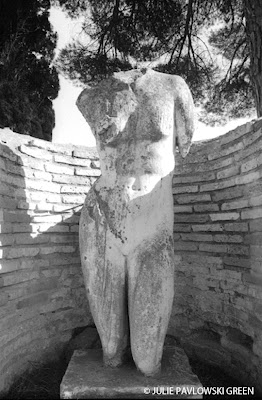Ostia Antica
I have often thought of the beautiful statues and the intricate mosaics I found strewn throughout Ostia Antica, an ancient harbor city which used to lay at the mouth of the Tibor River, 30 km west of Rome. I can still feel the heat of the sun and distinctly remember the sound of complete silence while I wandered the abandoned streets of this city. It had been erected as the principle port during the later Roman Empire and it was truly the global crossroad of culture and commerce. At its height of prosperity in the 2nd century BC, Ostia Antica had a population of 60,000 inhabitants!
The international population made Ostia Antica a very cosmopolitan city for the time. Knowing that men and woman from around the globe had walked these same streets in the 2nd century BC was intriguing for a gal who grew up where tumble weeds still rolled down the dusty small town streets of long forgotten California towns. It was humbling to be surrounded by such antiquity, much which had survived due to being buried in silt over the centuries. The archeological digging at Ostia Antica began in the 19th century and increased greatly between 1939 and 1942 under Benito Mussolini, when about 2/3 of the city was uncovered in preparation for the Esposizione Universale di Roma (EUR) 1942 Worlds-Fair that never took place.
The large and looming cypress trees felt like my ancestors, Aunties that were always watchful. Being half Italian, I felt connected and deeply rooted in the environs of this outdoor world. Could my Piedmonte and Tuscan relatives have ventured down to Rome to sell wine and marble? Asti and Piemonte were and still are the most important wine regions in Italy and many Roman structures were lined with marble pulled from the quarries in Pietrasanta in Tuscany. The thought wasn't inconceivable...
Wandering around the ruins of this ancient city, it's hard not to wonder what life must have been like for an average citizen back in the 201 BC. Baths, temples, theaters, taverns, gyms, warehouses and multi-story brick apartments known as Insula, where the majority of the urban population lived, were built in Ostia Antica. These warehouses and apartments were paved with mosaic floors and according to archeologists, their walls were elegantly painted. Magistrates were expected during this time to show their appreciation to the local population by providing the sculptures that adorned public places. As trade decreased in the 3rd century, the city became more of a residential place for wealthier Romans.
Ostia's Theater, which was originally erected at the end of the 1st century BC and was twice as high as can be seen in the image above, could seat 4,000 people. Not unlike the entertainment we seek in our modern day society, residences of Ostia Antica enjoyed music, performances, dance and sports to pass the time. This is one of the oldest brick Theaters in the world! The wonders of the Roman aqueducts provided water to the public Baths of Neptune, seen below, which is known for its large expansive Antonine black and white mosaic of Neptune riding a Chariot drawn by four horses through the sea.
But it was the mosaics on the floors of the apartments and warehouses that really garnered my attention. In a large area of the city was the Square of the Guilds containing 60 offices where tradesmen could sell their wares. Since it was one of the largest international market places of the time, it occurred to me that the mosaics acted as advertisements to signify the goods that were being sold, even if the seller and buyer could not speak the same language.
Upon further research of this ancient Roman city, I uncovered a religion based on the Indo-Iranian Sun God Mithra, which flourished from the 1st through the 4th century BC throughout the Roman Empire. The Mithraic Mysteries were practiced mainly by Roman soldiers in either a natural cave formation or a building that imitated the shape of a cave, usually below or within an existing structure, several which survive in Ostia. The entrance to a Mithraeum was identified by a single entrance. The cave like structure called the Spelaeum had raised benches along the walls where ritual meals were consumed.
The Roman cult of Mithras celebrated the metamorphoses of the four elements and their impact upon the world. The most important iconography of Mithras was usually portrayed showing him slaying a bull. As these images hung in the most prominent places in the mithraeum itself, it must have been a central myth for this Roman worship. It's interesting to note how so many scholars describe it as a pagan mystery religion or a cult. Perhaps because it never materialized into a world wide religion...
If you ever find yourself in Rome, do as the Romans did and visit Ostia Antica. You will be richly rewarded with a portal back in time.
Buon Viaggio!
Julie Pavlowski Green
May 4, 2013








I have not yet been to Rome or heard of Ostia Antica but it looks like an undervalued treasure.
ReplyDelete